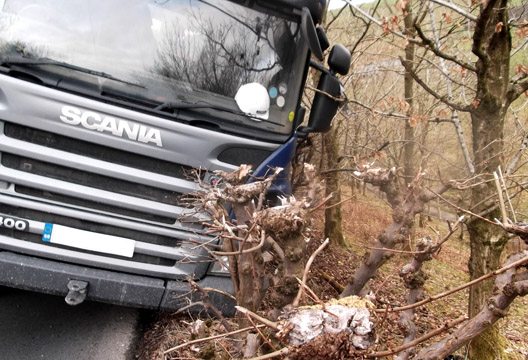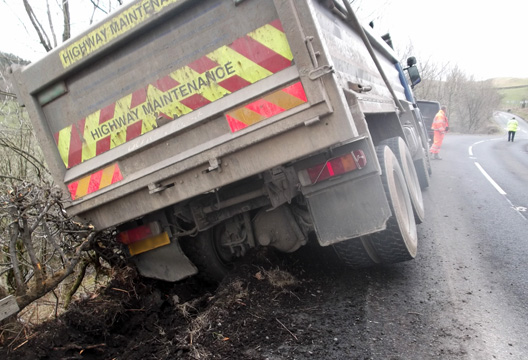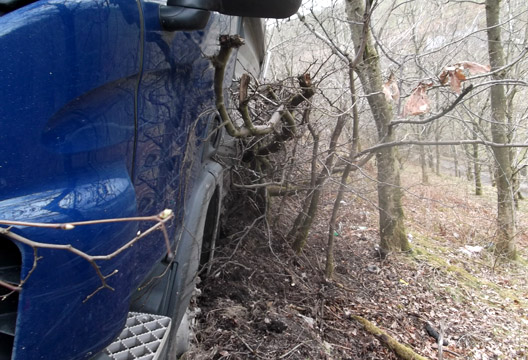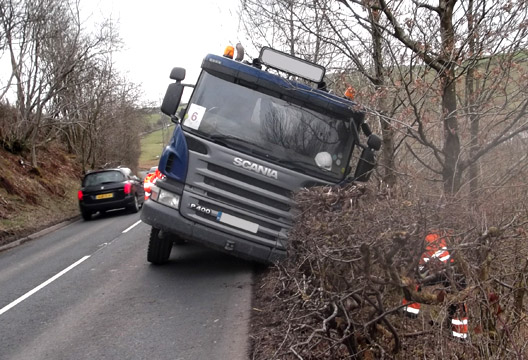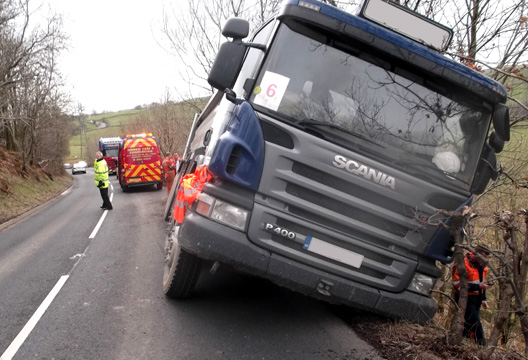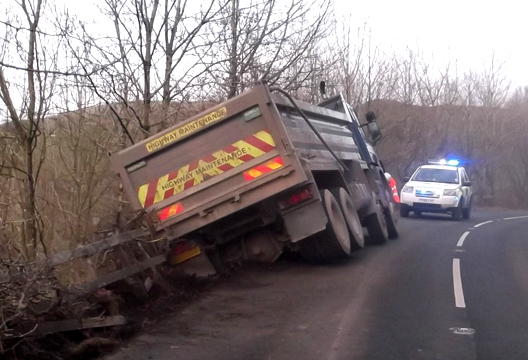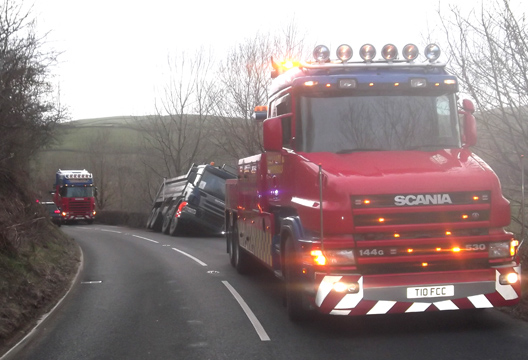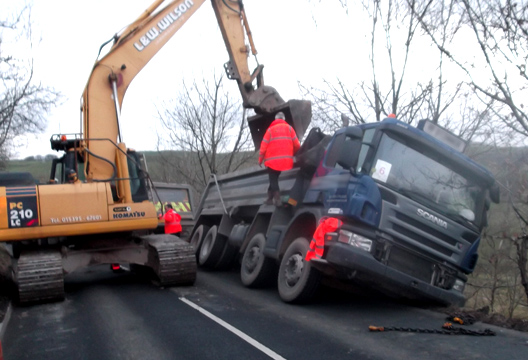Our Recovery Vehicles in action
Here are some recent case histories of recoveries we have undertaken.
Because every incident is different, the recovery vehicle we send to the location and the methods we use to assist and recover are also different.
Page 3
Recovery 9
Presented with this challenging and difficult recovery, both Kevin Grieve and Paul Grainger were dispatched along with our two commercial underlifts, T10 FCC and V10 FCC. At the scene the complexity of the recovery required was presented: the casualty vehicle had got too close to the edge of the road surface and, due to being fully loaded, had soon sunk into the soft ground and tilted to an angle of 45 degrees – only stopping when the axles of the vehicle contacted the road surface.
We decided it was too dangerous to attempt to recover the vehicle with the load intact, due to the vehicles position. So, before the recovery could begin, contractors were organised to remove the load from the vehicle, Once the load was removed and using our two commercial underlifts, T10 FCC and V10 FCC the vehicle was winched from its position back to the road surface, taking into consideration the steep embankment to the passenger side of the casualty vehicle.
Once back on the road with no damage, the vehicle had its goods reloaded and continued on its way. Once again, a very successful recovery.
Recovery 10
In this incident on the M6, the casualty vehicle had been involved in a single vehicle accident – the vehicle swerving after first going up the motorway embankment, turning onto its side and landing partly on the hard shoulder and partly in lane one.
Attending with our commercial underlift V10 FCC, we called our friends at Hough Green Garage of Widnes to assist using their commercial rotator. The reason for the call was that the vehicle had turned onto the driver’s side with its wheels and axles facing the motorway embankment, so it was going to be difficult for us to access this area which would be needed for our underlifts to right the vehicle. The recovery method selected was one which would allow recovery of the vehicle in its current position and allow lane three of the motorway to remain open during the recovery process.
Positioning our V10 FCC to the cab end of the vehicle and the Hough Green rotator to the trailer end in combination, we lifted the vehicle, with the load intact, back on to its wheels with relative ease.
Once back on its wheels the vehicle and trailer were secured along with its load and removed from the motorway along with all the debris caused by the accident. The motorway was returned to full operation in a very short period of time.
Recovery 11
A quick and simple example of what we do, this vehicle was attended on the M6 at Shap, a notorious area for large vehicles being caught out by the high winds and exposed landscape. We utilised our commercial underlifts, V10 FCC and T10 FCC. V10 FCC with its top boom was positioned to the rear of the vehicle taking care of lifting and supporting the trailer of the vehicle and T10 FCC was positioned to the front of the vehicle taking care of lifting and supporting the tractor unit.
As you can see from the images we began by winching the trailer up, closely followed by the tractor unit, bringing both together and as level as possible. Once the tipping point was reached, both the unit and trailer fell perfectly back into the upright position, ready to be loaded onto an underlift and cleared from the motorway.
Due to the narrow access road to the casualty vehicle location the only vehicle that we could access and perform the recovery of the vehicle was JC55 FCC – one of our spec lift recovery vehicles based at our Crooklands premises. Reversing our vehicle some distance and positioning it to the front of the casualty vehicle and attached our winching equipment to the front suspension of the casualty vehicle. However, it was too far in and wedged solid, so we had to use stone from a roadside wall to build up a road for the vehicle to be winched onto and gradually increased in order to bring the vehicle level.
Once the front end was up and out we repositioned our vehicle and with one final winch the vehicle was out! After a quick checkover, the vehicle was fine to carry on its way, without any damage caused during the recovery process.
This recovery was carried out by Paul Grainger and Gary Grieve with great success.
Recovery Demonstration
This video demonstrates the use of our specialist ‘full lift’ equipment based on our vehicle P999 FCC.
This equipment is used to recover vehicles in various situations when the wheels of the vehicle are not able to turn, whether this is due to a mechanical fault or for the purposes of evidence preservation when recovering a vehicle on behalf of the Police and Emergency Services.
The equipment is specially designed to lift from the wheels of the casualty vehicle, using wheel calipers which, as you will see, cradle the wheel and extend away from the wheel of the casualty vehicle. This enables it to be lifted without any contact with the main body of the casualty vehicle – preventing any damage. The lifting equipment is all hydraulically operated, therefore the casualty vehicle can be lifted in a level position from the ground to the recovery vehicle. You will note that during the recovery process the wheels of the casualty vehicle are not turned whatsoever.
This method of recovery is used in various different environments, including car parks, parking spaces and private driveways and is capable of lifting a casualty vehicle up to and including 3500KG.






